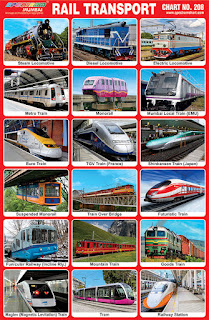Steam Locomotive - A steam
locomotive is a steam powered railway locomotive. It was used a lot
between about 1830 and 1970 later replace by diesel & electric
locomotives. Steam locomotives are still today used in many
developing countries where the railways have not yet been
electrified.
Diesel Locomotive - A
diesel locomotive is powered by a diesel engine. Diesel locomotives
are extremely popular worldwide, due to their ease of use and
reliability. They are more powerful than steam locomotives and do
not need an expensive power grid like electric locomotives.
Electric Locomotive - An
electric locomotive runs on electricity as the name suggests.
Electric locomotives cost the least to buy and operate. They are eco
friendly too. However, the railway electrification system is very
expensive, so only tracks used by many trains per day are usually
electrified.
Metro Train – Metro is a
type of high-capacity public transport generally found in urban
areas. Unlike bus's or trams, rapid transit systems are electric
railways that operate on an exclusive right-of-way, which cannot be
accessed by pedestrians or other vehicles.
Monorail – A monorail is
a railway in which the track consists of a single rail, typically
elevated. Monorails have found applications in airport transfer and
medium capacity metros.
Mumbai Local Train - Mumbai
Local Train operates more than 2,300 train services and carries more
than 7.5 million commuters daily. It is one of the busiest commuter
rail systems in the world and it has some of the most severe
overcrowding in the world. It is the oldest railway network in Asia
beginning its operations in April 1853.
Euro Train – Euro Train
(Eurostar) is a high-speed train service in Western Europe
connecting London and Kent in the U.K. with Paris and Lille in
France and Brussels in Belgium. All Eurostar trains cross the
English Channel through the Channel Tunnel. The service is operated
by 18-carriage Class 373 trains at up to 300 km/h on a network of
high-speed lines.
TGV Train – TGV (Train à
Grande Vitesse, French for "high-speed train"), is a
category of high speed trains. They are used in France. The trains
normally travel at speeds between 270 km/h and 320 km/h. They are
the fastest normal trains in the world, their average travel speed
is at 279.4 km/h.
Shinkansen Train –
Shinkansen is a group of high speed railway lines in Japan, upon
which the famous "Bullet Trains" run. Shinkansen uses a
range of advanced technology compared with conventional rail and it
achieved not only high speed but also a high standard of safety and
comfort.
Suspended Monorail – A
suspension railway is a form of elevated monorail where the vehicle
is suspended from a fixed track, which is built above street level,
over a river or canal or an existing railway track.
Funicular – A funicular,
also known as an inclined plane or cliff railway, is a cable railway
in which a cable attached to a pair of tram-like vehicles on rails
moves them up and down a steep slope, the ascending and descending
vehicles counterbalancing each other.
Mountain Train – A
mountain railway is a railway that operates in a mountain region. It
may operate through the mountains, for example by following mountain
valleys and tunneling beneath mountain passes. Or it may climb
mountains, in order to provide transport to and from their summits.
Goods Train – A freight
train or goods train is a group of freight cars or goods wagons
hauled by one or more locomotives on a railway, transporting cargo
all or some of the way between the shipper and the intended
destination as part of the logistics chain.
Maglev – Maglev is a
transport method that uses magnetic levitation to move vehicles
without touching the ground. With maglev, a vehicle travels along a
guideway using magnets to create both lift and propulsion, thereby
reducing friction by a great extent and allowing very high speeds.
Tram - A tram is a
passenger vehicle that is like a train which run on dedicated tracks
on the road within cities. Trams first came into use in the 1890's.
Railway Station - Railway
station is a railway facility where trains regularly stop to load or
unload passengers or freight. It generally consists of at least one
track-side platform and a station building.


No comments:
Post a Comment